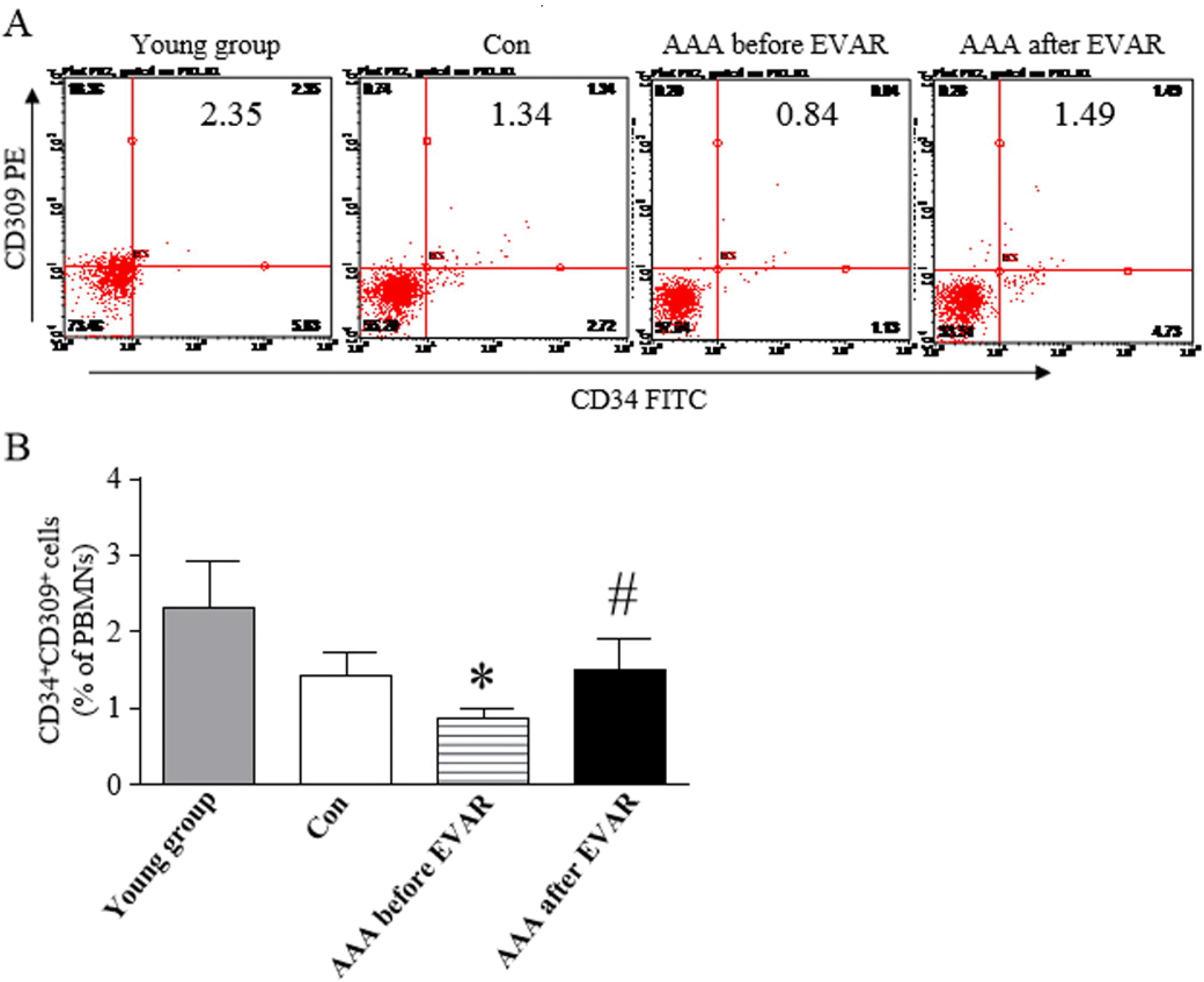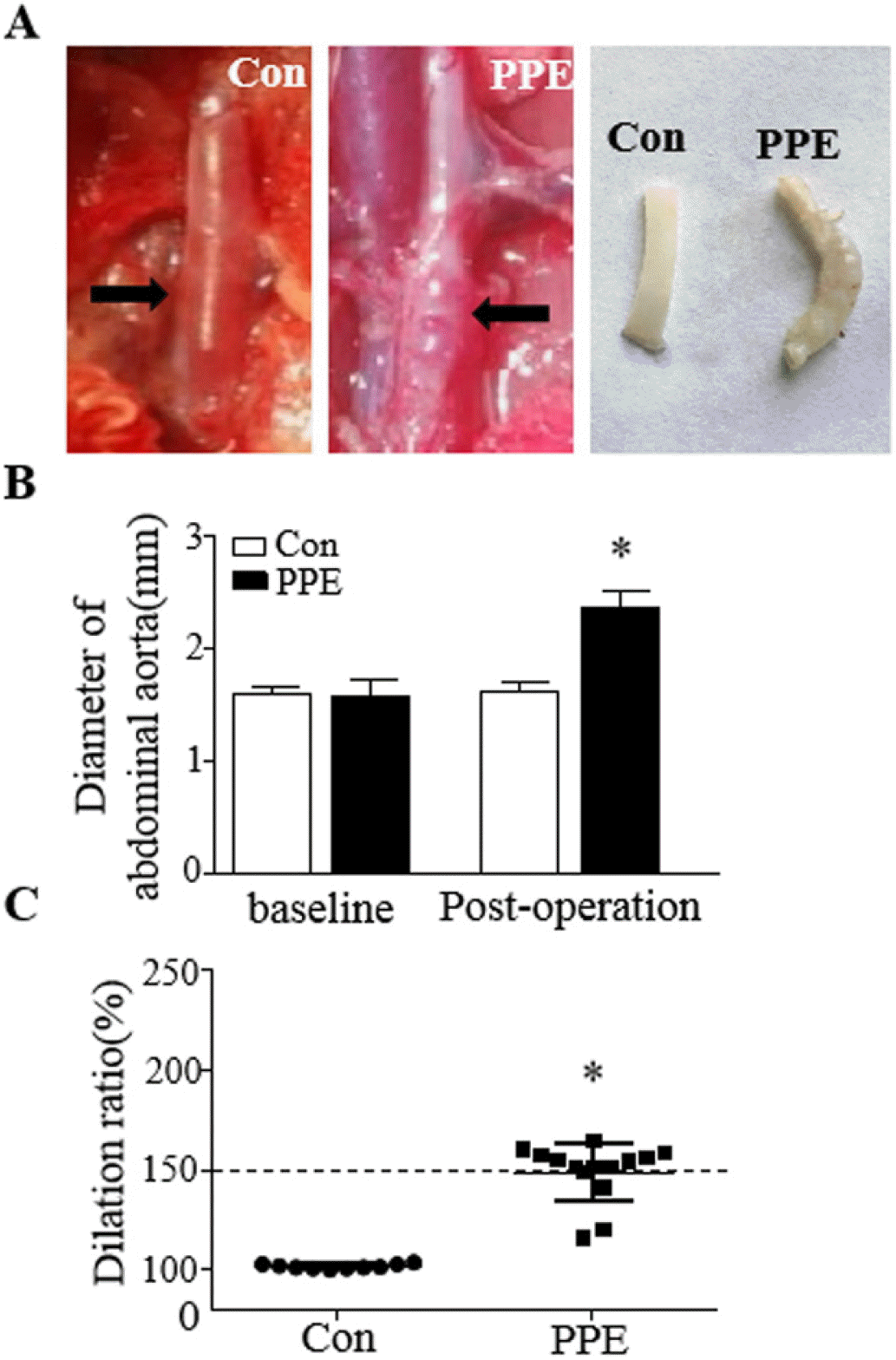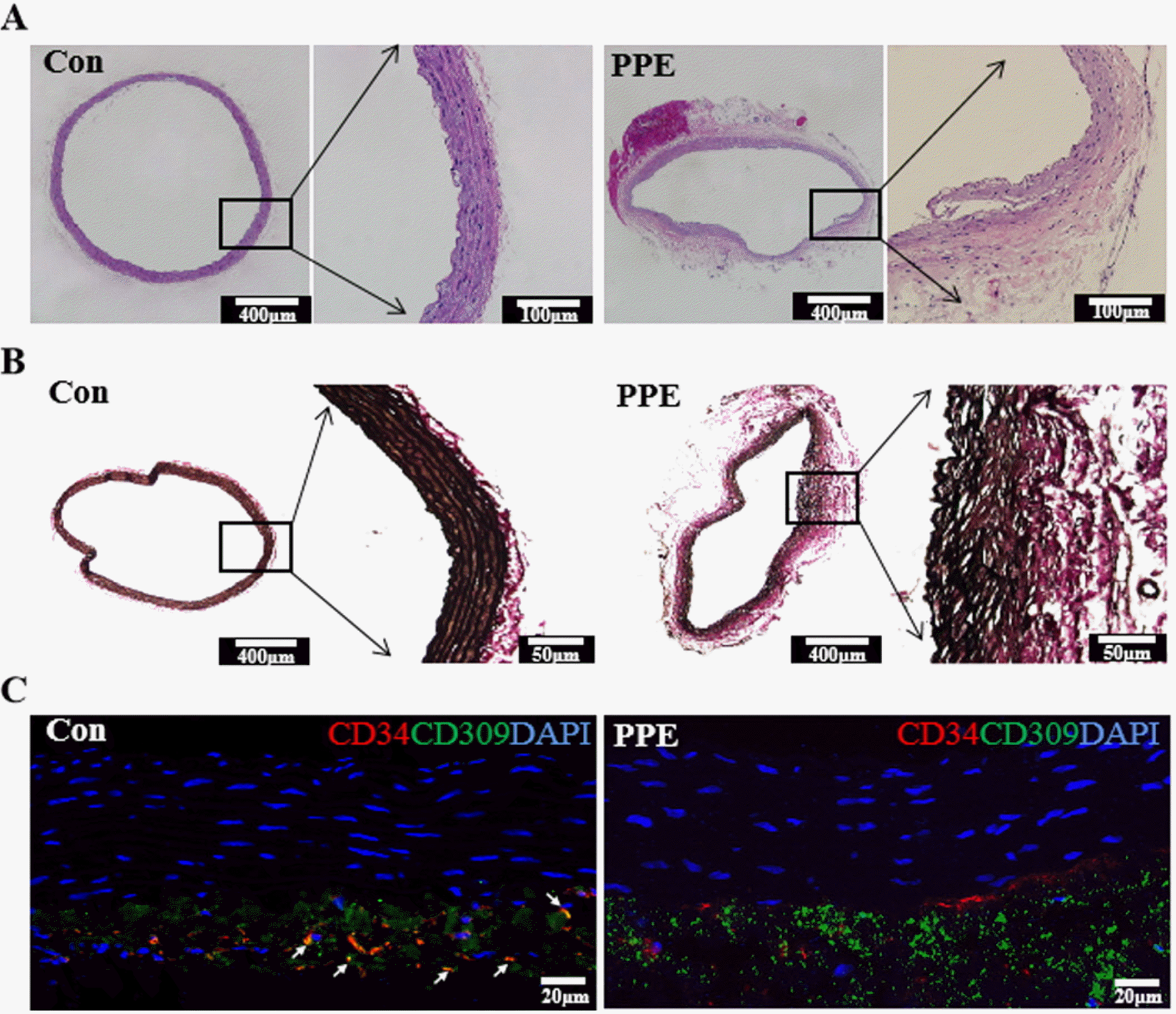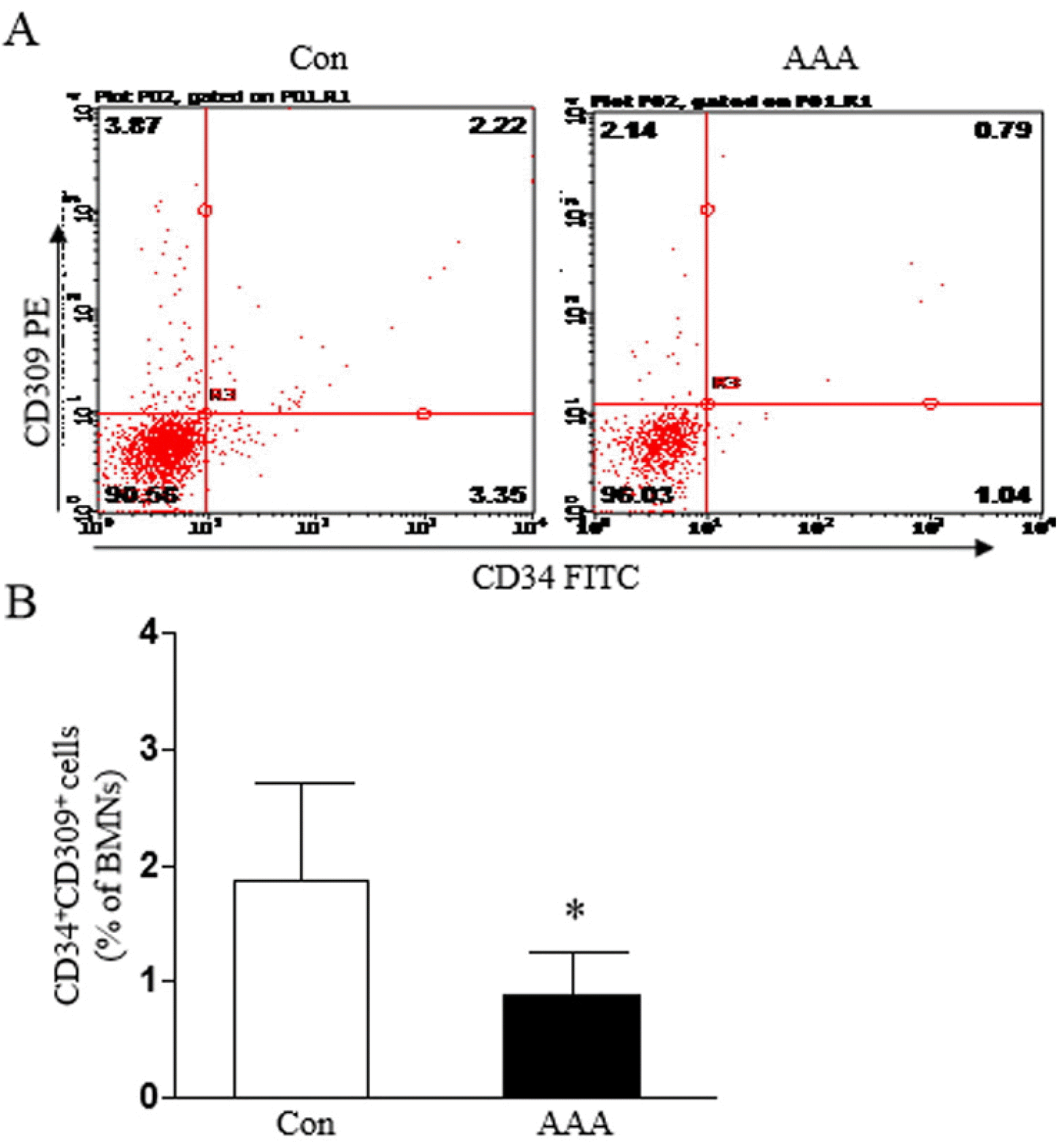1. Aggarwal S, Qamar A, Sharma V, Sharma A. 2011; Abdominal aortic aneurysm: a comprehensive review. Exp Clin Cardiol. 16:11–15. PMID:
21523201. PMCID:
PMC3076160.
3. Altobelli E, Rapacchietta L, Profeta VF, Fagnano R. 2018; Risk factors for abdominal aortic aneurysm in population-based studies: a systematic review and meta-analysis. Int J Environ Res Public Health. 15:2805. DOI:
10.3390/ijerph15122805. PMID:
30544688. PMCID:
PMC6313801.

4. Parietti E, Pallandre JR, Deschaseaux F, Aupècle B, Durst C, Kantelip JP, Chocron S, Davani S. 2011; Presence of circulating endothelial progenitor cells and levels of stromal-de-rived factor-1α are associated with ascending aorta aneurysm size. Eur J Cardiothorac Surg. 40:e6–e12. DOI:
10.1016/j.ejcts.2011.02.065. PMID:
21481600.

5. Hayek SS, MacNamara J, Tahhan AS, Awad M, Yadalam A, Ko YA, Healy S, Hesaroieh I, Ahmed H, Gray B, Sher SS, Ghasemzadeh N, Patel R, Kim J, Waller EK, Quyyumi AA. 2016; Circulating progenitor cells identify peripheral arterial disease in patients with coronary artery disease. Circ Res. 119:564–571. DOI:
10.1161/CIRCRESAHA.116.308802. PMID:
27267067. PMCID:
PMC4975640.

6. Dawson J, Tooze J, Cockerill G, Choke E, Loftus I, Thompson MM. 2006; Endothelial progenitor cells and abdominal aortic aneurysms. Ann N Y Acad Sci. 1085:327–330. DOI:
10.1196/annals.1383.011. PMID:
17182952.

7. Sung SH, Wu TC, Chen JS, Chen YH, Huang PH, Lin SJ, Shih CC, Chen JW. 2013; Reduced number and impaired function of circulating endothelial progenitor cells in patients with abdominal aortic aneurysm. Int J Cardiol. 168:1070–1077. DOI:
10.1016/j.ijcard.2012.11.002. PMID:
23182004.

8. Chong MS, Ng WK, Chan JK. 2016; Concise review: endothelial progenitor cells in regenerative medicine: applications and challenges. Stem Cells Transl Med. 5:530–538. DOI:
10.5966/sctm.2015-0227. PMID:
26956207. PMCID:
PMC4798740.

9. Leake AE, Segal MA, Chaer RA, Eslami MH, Al-Khoury G, Makaroun MS, Avgerinos ED. 2017; Meta-analysis of open and endovascular repair of popliteal artery aneurysms. J Vasc Surg. 65:246–256.e2. DOI:
10.1016/j.jvs.2016.09.029. PMID:
28010863.

10. Ammar AD. 2019; Mortality for open abdominal aortic aneurysm repair before and after endovascular aortic repair (EVAR). Am Surg. 85:1341–1344. DOI:
10.1177/000313481908501226. PMID:
31908215.

11. Dua A, Koprowski S, Upchurch G, Lee CJ, Desai SS. 2017; Progressive shortfall in open aneurysm experience for vascular surgery trainees with the impact of fenestrated and branched endovascular technology. J Vasc Surg. 65:257–261. DOI:
10.1016/j.jvs.2016.08.075. PMID:
27743805.

12. Zhou B, Cao XC, Fang ZH, Zheng CL, Han ZB, Ren H, Poon MC, Han ZC. 2007; Prevention of diabetic microangiopathy by prophylactic transplant of mobilized peripheral blood mononuclear cells. Acta Pharmacol Sin. 28:89–97. DOI:
10.1111/j.1745-7254.2007.00476.x. PMID:
17184587.

13. Zheng H, Shen CJ, Qiu FY, Zhao YB, Fu GS. 2010; Stromal cell-derived factor 1alpha reduces senescence of endothelial progenitor subpopulation in lectin-binding and DiLDL-uptaking cell through telomerase activation and telomere elongation. J Cell Physiol. 223:757–763. DOI:
10.1002/jcp.22086. PMID:
20232301.
14. Hu G, Dong Z, Fu W. 2017; A novel modification of the murine elastase infusion model of abdominal aortic aneurysm formation. Ann Vasc Surg. 42:246–253. DOI:
10.1016/j.avsg.2017.01.006. PMID:
28288888.

16. Weng X, Yu L, Liang P, Chen D, Cheng X, Yang Y, Li L, Zhang T, Zhou B, Wu X, Xu H, Fang M, Gao Y, Chen Q, Xu Y. 2015; Endothelial MRTF-A mediates angiotensin II induced cardiac hypertrophy. J Mol Cell Cardiol. 80:23–33. DOI:
10.1016/j.yjmcc.2014.11.009. PMID:
25446178.

17. Balistreri CR, Ruvolo G, Lio D, Madonna R. 2017; Toll-like receptor-4 signaling pathway in aorta aging and diseases: "its double nature". J Mol Cell Cardiol. 110:38–53. DOI:
10.1016/j.yjmcc.2017.06.011. PMID:
28668304.

18. Zhang H, Liu J, Qu D, Wang L, Wong CM, Lau CW, Huang Y, Wang YF, Huang H, Xia Y, Xiang L, Cai Z, Liu P, Wei Y, Yao X, Ma RCW, Huang Y. 2018; Serum exosomes mediate delivery of arginase 1 as a novel mechanism for endothelial dysfunction in diabetes. Proc Natl Acad Sci U S A. 115:E6927–E6936. DOI:
10.1073/pnas.1721521115. PMID:
29967177. PMCID:
PMC6055191.

19. Huang PH, Chen YH, Chen YL, Wu TC, Chen JW, Lin SJ. 2007; Vascular endothelial function and circulating endothelial progenitor cells in patients with cardiac syndrome X. Heart. 93:1064–1070. DOI:
10.1136/hrt.2006.107763. PMID:
17488770. PMCID:
PMC1954999.

20. Li DW, Liu ZQ, Wei J, Liu Y, Hu LS. 2012; Contribution of endothelial progenitor cells to neovascularization (Review). Int J Mol Med. 30:1000–1006. DOI:
10.3892/ijmm.2012.1108. PMID:
22922670.
22. Etemadifar M, Dehghani L, Ganji H, Soleimani R, Talebi M, Eskandari N, Samani FS, Meamar R. 2015; Evaluation of the circulating CD34(+), CD309(+), and endothelial progenitor cells in patients with first attack of optic neuritis. Adv Biomed Res. 4:151. DOI:
10.4103/2277-9175.161578. PMID:
26380236. PMCID:
PMC4550950.

23. Fritzenwanger M, Lorenz F, Jung C, Fabris M, Thude H, Barz D, Figulla HR. 2009; Differential number of CD34+, CD133+ and CD34+/CD133+ cells in peripheral blood of patients with congestive heart failure. Eur J Med Res. 14:113–117. DOI:
10.1186/2047-783X-14-3-113. PMID:
19380281. PMCID:
PMC3352059.

24. Friedrich EB, Walenta K, Scharlau J, Nickenig G, Werner N. 2006; CD34-/CD133+/VEGFR-2+ endothelial progenitor cell subpopulation with potent vasoregenerative capacities. Circ Res. 98:e20–e25. DOI:
10.1161/01.RES.0000205765.28940.93. PMID:
16439688.
25. Liao YF, Chen LL, Zeng TS, Li YM, Fan Yu, Hu LJ, Ling Yue. 2010; Number of circulating endothelial progenitor cells as a marker of vascular endothelial function for type 2 diabetes. Vasc Med. 15:279–285. DOI:
10.1177/1358863X10367537. PMID:
20511292.

26. Gu S, Zhang W, Chen J, Ma R, Xiao X, Ma X, Yao Z, Chen Y. 2014; EPC-derived microvesicles protect cardiomyocytes from Ang II-induced hypertrophy and apoptosis. PLoS One. 9:e85396. DOI:
10.1371/journal.pone.0085396. PMID:
24392165. PMCID:
PMC3879348.

27. Huang WP, Yin WH, Chen JS, Huang PH, Chen JW, Lin SJ. 2020; Fenofibrate reverses dysfunction of EPCs caused by chronic heart failure. J Cardiovasc Transl Res. 13:158–170. DOI:
10.1007/s12265-019-09889-y. PMID:
31701352.

28. Fadini GP, Coracina A, Baesso I, Agostini C, Tiengo A, Avogaro A, de Kreutzenberg SV. 2006; Peripheral blood CD34+KDR+ endothelial progenitor cells are determinants of subclinical atherosclerosis in a middle-aged general popu-lation. Stroke. 37:2277–2282. DOI:
10.1161/01.STR.0000236064.19293.79. PMID:
16873710.

29. Eizawa T, Ikeda U, Murakami Y, Matsui K, Yoshioka T, Suzuki C, Takahashi M, Muroi K, Kamisawa O, Fuse K, Shimada K. 2004; Increase in circulating endothelial progenitor cells after aortic aneurysm repair. Heart Vessels. 19:107–110. DOI:
10.1007/s00380-003-0751-7. PMID:
15168056.

30. Lacquaniti A, Giardina M, Lucisano S, Messina R, Buemi A, Risitano CD, Chirico V, Buemi M, David A. 2013; Neutrophil gelatinase-associated lipocalin (NGAL) and endothelial progenitor cells (EPCs) evaluation in aortic aneurysm repair. Curr Vasc Pharmacol. 11:1001–1010. DOI:
10.2174/157016111106140128124607. PMID:
22724477.

31. Rigato M, Avogaro A, Fadini GP. 2016; Levels of circulating progenitor cells, cardiovascular outcomes and death: a meta-analysis of prospective observational studies. Circ Res. 118:1930–1939. DOI:
10.1161/CIRCRESAHA.116.308366. PMID:
27073015.

32. Buffa S, Borzì D, Chiarelli R, Crapanzano F, Lena AM, Nania M, Candi E, Triolo F, Ruvolo G, Melino G, Balistreri CR. 2019; Biomarkers for vascular ageing in aorta tissues and blood samples. Exp Gerontol. 128:110741. DOI:
10.1016/j.exger.2019.110741. PMID:
31648011.

33. Balistreri CR, Crapanzano F, Schirone L, Allegra A, Pisano C, Ruvolo G, Forte M, Greco E, Cavarretta E, Marullo AGM, Sciarretta S, Frati G. 2018; Deregulation of Notch1 pathway and circulating endothelial progenitor cell (EPC) number in patients with bicuspid aortic valve with and without ascending aorta aneurysm. Sci Rep. 8:13834. DOI:
10.1038/s41598-018-32170-2. PMID:
30218064. PMCID:
PMC6138685. PMID:
cb1af62bbb1a40608db4adefa71c4b88.

34. Canning P, Tawfick W, Whelan N, Hynes N, Sultan S. 2019; Cost-effectiveness analysis of endovascular versus open repair of abdominal aortic aneurysm in a high-volume center. J Vasc Surg. 70:485–496. DOI:
10.1016/j.jvs.2018.11.018. PMID:
30777686.

35. Bhamidipati CM, Mehta GS, Lu G, Moehle CW, Barbery C, DiMusto PD, Laser A, Kron IL, Upchurch GR Jr, Ailawadi G. 2012; Development of a novel murine model of aortic aneurysms using peri-adventitial elastase. Surgery. 152:238–246. DOI:
10.1016/j.surg.2012.02.010. PMID:
22828146. PMCID:
PMC3601193.

36. Anidjar S, Salzmann JL, Gentric D, Lagneau P, Camilleri JP, Michel JB. 1990; Elastase-induced experimental aneurysms in rats. Circulation. 82:973–981. DOI:
10.1161/01.CIR.82.3.973. PMID:
2144219.

37. Busch A, Chernogubova E, Jin H, Meurer F, Eckstein HH, Kim M, Maegdefessel L. 2018; Four surgical modifications to the classic elastase perfusion aneurysm model enable haemodynamic alterations and extended elastase perfusion. Eur J Vasc Endovasc Surg. 56:102–109. DOI:
10.1016/j.ejvs.2018.03.018. PMID:
29703523.









 PDF
PDF Citation
Citation Print
Print


 XML Download
XML Download